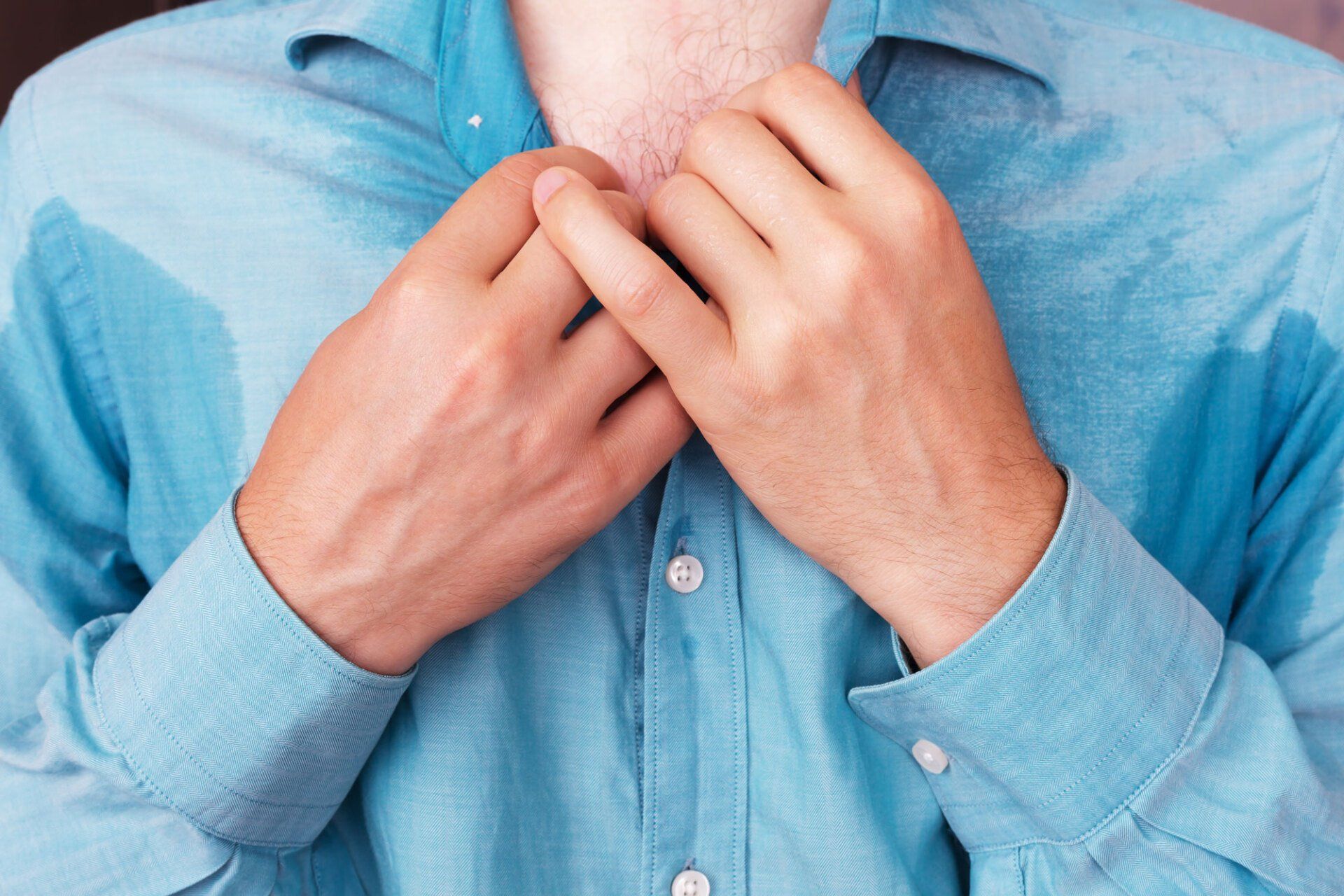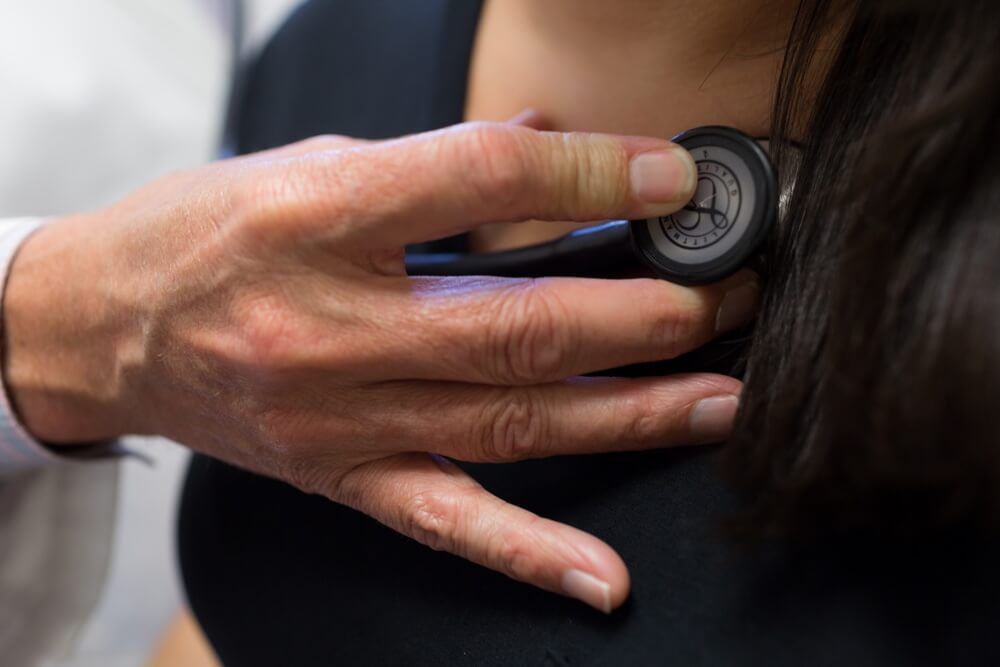Excessive Sweating
Everybody sweats. This is just a simple fact. Sweating is the body's natural reaction to prevent overheating. However, some people have issues with sweat that go beyond the status quo. These people suffer from hyperhidrosis, otherwise known as excessive sweating, making it difficult to simply even walk outside on a warm day without needing a new shirt. California Dermatology and Clinical Research Institute has research studies with investigational medications for hyperhidrosis.
WHAT IS HYPERHIDROSIS?
Hyperhidrosis is an ailment that afflicts 2% to 3% of the population that causes issues with sweating in a variety of circumstances. People with hyperhidrosis have sweat glands that refuse to shut off even after the body temperature is back to normal. Not only do the glands refuse to stop producing sweat when it is no longer needed, but people with hyperhidrosis will sweat in circumstances when sweating is unnecessary. Meaning, sweating profusely in an air conditioned room, becoming uncomfortably sweaty on a cool winter day, or even sweat in the relaxing comfort of a swimming pool!
Contact Us
Contact Us
WHAT ARE THE SYMPTOMS OF HYPERHIDROSIS?
Hyperhidrosis is diagnosed when the amount that a person sweats disrupts their everyday life, without a clear reason. Here are some of the most common symptoms of hyperhidrosis.
CLAMMY PALMS
A handshake is an essential part of an introduction, be it in business, your personal life, or just meeting a stranger on the streets. Those with hyperhidrosis approach every handshake with dread, as a simple handshake means explaining why their palms are as clammy as a fish shop.
SWEATY FEET THAT CAUSE ODOR
Hyperhidrosis can cause excessive sweating on the soles of the feet, causing an embarrassing odor that can be difficult to hide. Sweaty feet can be an annoying inconvenience, causing people to purchase new shoes and socks on a regular basis. The increased sweating can also make certain infections more common as microorganisms enjoy warm, wet environments.

SWEATING THROUGH CLOTHING
If only sweat was invisible. If you are frequently sweating from hyperhidrosis, there is no hiding the evidence of your ailment, as the sweat will soak right through clothing and make you immediately look like a slob.
WHAT OTHER ISSUES CAN EXCESSIVE SWEATING CAUSE?
Excessive sweating can have far-reaching consequences beyond the actual act of sweating. People with hyperhidrosis can have a number of issues that occur as a result of their profuse sweating.
SKIN ISSUES FROM EXCESSIVE SWEAT
An excessive amount of sweat can cause skin issues. Added moisture on the skin can create a breeding ground for bacterial and fungal infections, potentially making for itchy, painful and irritating skin problems.
WARDROBE ISSUES AND LIMITATIONS
If you suffer from hyperhidrosis, unfortunately wearing white is simply out of the equation, unless you are an exhibitionist trying to put on your own personal wet t-shirt contest. This is just one example of the wardrobe limitations that come with hyperhidrosis, which also includes the need to frequently replace clothing.
A RELUCTANCE TO PHYSICAL CONTACT TO AVOID EMBARRASSMENT
If sweat is a constant concern, embracing another person in a hug means dousing them in healthy dose of sweat. The constant threat of embarrassment due to sweat can lead those with hyperhidrosis to actively avoid physical contact with others.
INABILITY TO PURSUE CERTAIN CAREERS AND JOBS
Certain jobs require close human interactions or physical contact, and constant sweating can make a career in these fields impossible. In jobs that require both physical exertion and customer service, the amount someone with hyperhidrosis sweats can make a customer unbearably uncomfortable.
BODY ODOR ISSUES FROM EXCESSIVE SWEAT
It can be stated, with authority, that nobody wants to smell bad. Those with hyperhidrosis are constantly fighting off the bad odor that comes with excessive sweat, trying out prescription deodorants or other means to reduce the scent.
WHAT OTHER ISSUES CAN EXCESSIVE SWEATING CAUSE?
Excessive sweating can have far-reaching consequences beyond the actual act of sweating. People with hyperhidrosis can have a number of issues that occur as a result of their profuse sweating.
SKIN ISSUES FROM EXCESSIVE SWEAT
Excessive sweat can create skin issues due to the added moisture on the skin, creating a breeding ground for bacterial and fungal infections. This can make for itchy, painful and irritating skin problems.
WARDROBE ISSUES AND LIMITATIONS
If you suffer from hyperhidrosis, wearing white is unfortunately out of the equation, unless you are an exhibitionist trying to put on your own personal wet t-shirt contest. This is just one example of the wardrobe limitations that come with hyperhidrosis, which also includes the need to frequently replace clothing.
A RELUCTANCE TO PHYSICAL CONTACT TO AVOID EMBARRASSMENT
If sweat is a constant concern, embracing another person in a big hug means dousing them in healthy dose of sweat. The constant threat of embarrassment because of sweat can lead those with hyperhidrosis to actively avoid physical contact with others.
INABILITY TO PURSUE CERTAIN CAREERS AND JOBS
Certain jobs require close human interactions or physical contact, and constant sweating can make a career in these fields impossible. In jobs that require both physical exertion and customer service, the amount someone with hyperhidrosis sweats can make a customer uncomfortable.
BODY ODOR ISSUES FROM EXCESSIVE SWEAT
It can be stated with authority that nobody wants to smell bad. Those with hyperhidrosis are constantly fighting off the bad odor that comes with excessive sweat, trying out prescription deodorants or other means to reduce the scent.
WHAT CAUSES HYPERHIDROSIS?
The cause of excessive sweating depends on the type of hyperhidrosis that person suffers from. There are two different types of hyperhidrosis that both affect different parts of the body for different reasons.
PRIMARY HYPERHIDROSIS
Primary hyperhidrosis causes extreme and excessive sweating in the underarms, hands, feet, and on the face. These are the eccrine sweat glands, and they make up most of the sweat glands in your body. Currently, the cause of primary hyperhidrosis is unknown, although scientists posit that it may be hereditary. You have nerve endings near sweat glands that cause you to sweat, so people with primary hyperhidrosis have nerves that are overly sensitive and overactive.
SECONDARY HYPERHIDROSIS
Secondary hyperhidrosis hits a larger area of the body with excessive sweating, with sweat pouring out from all over the body. Unlike primary hyperhidrosis, the symptoms of secondary hyperhidrosis usually occur primarily when you are asleep. This type of hyperhidrosis is usually caused by a preexisting medical issue or a medication that causes a reaction. Some medical conditions that can cause secondary hyperhidrosis include pregnancy, diabetes, menopause, parkinson's disease and lymphoma, just to name a few.
HOW IS HYPERHIDROSIS DIAGNOSED?
To begin diagnosing someone with hyperhidrosis, making sure the excessive sweating is not a symptom of another preexisting condition. Conditions such as an overactive thyroid or low blood sugar can cause individuals to sweat more than usual, so tests must be conducted to make sure these conditions are not the cause of the profuse sweating.
When other conditions have been ruled out, the doctor will ask a series of questions to get insight into how severe the excessive sweating is and to see what spurs the sweat. To quantify how much sweat is produced, a gravimetric sweat test can be performed. This is simply collecting the sweat on a piece of paper or gauze and weighing it to see how much sweat is made. In most cases this is not necessary as the diagnosis of hyperhidrosis is made by asking the patient questions regarding how much they sweat and how they compensate for it.

HOW DO YOU TREAT HYPERHIDROSIS AND STOP SWEATING?
There are a few methods to attempt to treat hyperhidrosis. It is possible to live a happy life with hyperhidrosis, and some of these treatments may help.
PRESCRIPTION ANTIPERSPIRANTS WITH ALUMINUM CHLORIDE
The first step to trying to treat hyperhidrosis is usually a prescription antiperspirant. Prescription strength products have higher concentrations of aluminum chloride which is the active ingredient in most OTC products. These higher concentrations CAN help but usually only for those with mildly excessive sweating.
ARMPIT SHIELDS TO PROTECT CLOTHING FROM SWEAT DAMAGE
This measure may not do much to treat hyperhidrosis, but it does work to prevent puddles of sweat from ruining your favorite shirt. Armpit shields are pads that you put in your armpit to prevent sweat from dripping onto your shirt, preventing sweat pools and yellow stains from armpit sweat. This can be very helpful to those with hyperhidrosis who can otherwise ruin shirts in just one or two wearings.
SWEAT PROOF CLOTHING, SHOES AND SOCKS
There have been amazing recent innovations when it comes to sweat proofing clothes, shoes, and socks. Equip yourself with loose clothing, avoiding synthetic fibers, that allows your skin to breathe more easily. Shoes with natural material such as leather may do a better job of curbing excessive sweat, while there are socks made particularly for people who sweat a lot. Rotating shoes can help as well. Allowing shoes to “breathe” and dry out for a day will help them last longer and smell better.
IONTOPHORESIS TREATMENT
Iontophoresis is a very interesting treatment for hyperhidrosis suggested by some dermatologists, with varying degrees of success. The procedure consists of someone putting their hands and feet in pans of water, with a small current of electricity being passed through the water. This painless procedure lasts 20 to 30 minutes at first then just short intervals of treatment to maintain the effect. It is best for excess sweating of the hands or feet. Specialized electrical units are sold for this purpose that must be prescribed by a physician.
BOTOX INJECTIONS INTO THE SWEAT GLANDS
Botox injections can work to block the nerves in sweat glands that tell the body to sweat. These injections can cause the individual to virtually stop sweating in the areas treated, with several injections needed for best results. It lasts 6-9 months and then must be repeated.
PRESCRIPTION FOR ANTICHOLINERGIC DRUGS
Anticholinergic drugs work to reduce parasympathetic nerves from transmitting to sweat glands, hopefully resulting in a reduction of sweat. After taking these medications for 2 weeks, patients should begin to see positive results. These medications can cause side effects that, although not harmful, can be hard for many persons to tolerate, making them less popular than other treatments.
IN EXTREME CASES, ENDOSCOPIC THORACIC SYMPATHECTOMY (ETS) SURGERY
This surgery should only be the last option. If a patient is not responding to other treatments and hyperhidrosis is taking over their lives, the dermatologist may opt for endoscopic thoracic sympathectomy (ETS). This procedure consists of a surgeon interrupting the nerves that connect to sweat glands.

